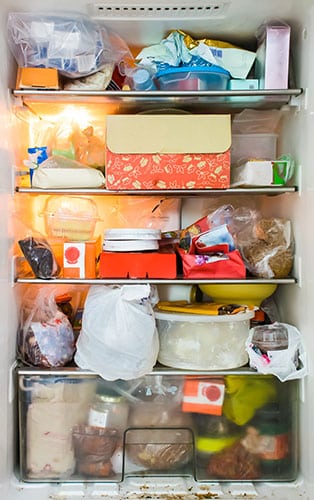“48 million Americans suffer from food poisoning each year”. Today’s bacteria are more virulent and harder to control than past years. Due to antibiotic overuse in the animal population, coupled with resistance to pesticides, it becomes more difficult to keep our food sources healthy and us safe. Another common practice of liberally using hand sanitizers over soap and water has affected our ability to temper food poisoning. Food poisoning is on the rise and holds higher consequences for the young, the old, those with immune disorders and those who suffer from a chronic illness such as diabetes.
Simple food poisoning can present as a stomach ache, nausea or vomiting. In severe cases, it may cause a high fever, blood in the stool and dehydration requiring hospitalization. Bacteria, parasites and viruses grow in the “temperature danger zone” over 40 degrees F or below 140 degrees. Here are 15 quick tips which can keep you healthy in the kitchen and beyond from food poisoning when you have diabetes.
1. Wash Hands with Soap and Water
I start out many articles with this exact statement and it still applies to cutting the risk of problems in the kitchen. Prior to any food preparation or grabbing something to eat, the best way to stay germ free is to wash hands with warm water and soap for a minimum of 20 seconds. Add repeated hand washing when working with raw foods including meat, poultry and eggs. Dry hands with a single paper towel or fresh kitchen towel that has not been used to wipe down counter tops. Always wash hands after handling garbage or trash.
2. Cutting Boards and Cross Contamination
Wood and plastic cutting boards each have advantages and disadvantages. Wood cutting boards are attractive and a good choice when they are made of hard wood such as Maple or Beech. These hard woods prevent splintering which allow and hold onto bacteria and germs. Cypress wood, which is extremely soft, is a poor choice for a cutting board. Wood cutting boards also allow knives to stay sharper. If using a wood board, wash carefully using a sanitizing product, dry and then air completely and apply mineral oil to the surface to maintain it properly. Plastic cutting boards are easy to clean but when sharp grooves and scars allow bacteria to get in quickly. Plastic boards can be sanitized by using a bleach spray product or making your own from one tablespoon of Clorox Bleach in one gallon of water. Plastic cutting boards can be placed in the dish washer at high temperatures for sanitizing. Since they are usually inexpensive, change plastic boards more frequently. The most important thing to remember is to use one cutting board for raw foods and place in the sink immediately. Take a second cutting board and a second knife after you have washed your hands to prepare other foods to prevent cross contamination.
3. Sponges and Dish Rags
Wet sponges and dish rags can harbor mold, yeast and bacteria from the moisture. After use, wash sponges in hot soapy water. You can place them in the dishwasher or microwave which will kill 99% of the bacteria. Sanitize sponges every other day and replace them often.
4. Do Not Rinse Raw Meat Prior To Cooking
People assume raw meat should be rinsed prior to cooking. Rinsing raw meat actually spreads bacteria around the sink and counter tops which can affect other foods close by. The Dietary Guidelines for Americans recommends “not rinsing raw meat and poultry before cooking”. Bacteria are destroyed with the heat of the cooking process. Do carefully wash and rinse all fresh fruit and vegetables prior to eating or cooking.
5. Be Wary of Bacteria in Foods

6. Properly Defrost Food
Many people think it is OK to defrost food at room temperature on the counter top or in the sink. It is wise to thaw in the refrigerator or in the microwave to avoid ‘The Temperature Danger Zone’ otherwise more bacteria will be present.
7. Cook Foods Completely.
Do Not Assume Food Is Thoroughly Cooked Just By Looking At It. When cooking burgers, poultry, and pork, make sure food is fully cooked by inserting a digital or dial thermometer so that you can confirm that the meat has obtained an internal temperature of 165 degrees F. This is helpful in grilling, baking or roasting to make sure the food will not expose you to bacteria especially since under-cooked meat can cause E-Coli. Look for an APP called Is My Food Safe? It offers a complete list of safe cooking temperatures for different foods.
8. Properly Marinate Food
Place foods in the refrigerator when marinating, not at room temperature, and do not reuse marinade for cooked food. Leave some marinade which has not touched the raw food for dipping.
9. Putting Food Away
Once food is prepared and eaten, place the leftovers in the refrigerator within 1 hour in warm weather and within 2 hours in cool weather. Keeping food cool will prevent the growth of bacteria. If on a picnic, remember to pack food in a well insulated cooler to protect your food.
10. Do Not Leave Hot Food Out
Do not place hot foods on the counter for more than 30 minutes which could cause the spread of bacteria. If you have cooked large portions of soups, stews or casseroles, place them in smaller containers no deeper than 2 inches to let them cool more quickly and place in the refrigerator.
11. The Proper Way to Reheat Food
When taking leftovers out of the refrigerator, reheat foods to a full boil or bubble before eating. This includes soups, stews, crock pot and casseroles. Mix foods thoroughly so the internal temperature gets to 165 F and is evenly heated.
12. Do Not Overstuff The Refrigerator

13. Wash Reusable Grocery Bags Often
Although wonderful for the environment, it is recommended that you frequently wash these reusable bags. Raw meat, poultry and eggs can leave behind bacteria which can transfer to your next shopping trip. If the reusable bags are plastic then rinse them with an antibacterial spray with each use and completely air dry. When packing foods in the store keep hot foods, raw foods and packaged foods separate to help cut down on the spread of bacteria. Paper goods and cleaning supplies should always be separated from food.
14. Dispose of Leftovers After a Few Days
Consume or dispose of leftovers within 3-4 days for a safer bet. Try to cook smart by planning portions since “30-40% of the food supply in the US ends up as waste”. Freezing leftovers is easy and can be used at a later date.
15. Dispose Of Expired Food
You may not be able to smell or see changes in your food that contains bacteria so be on the safe side and dispose of expired food. Be alert to foods that have been recalled and never use them.
Use these tips to stay safe in the kitchen. People with diabetes are more at risk for infections so be cautious and stay healthy!
Have a question or comment? Post below or email me at RKleinman@adwdiabetes.com if you would like to share them with ADW diabetes.
NOTE: Consult your Doctor first to make sure my recommendations fit your special health needs.







Leave A Comment